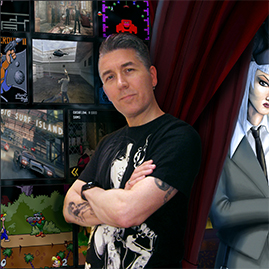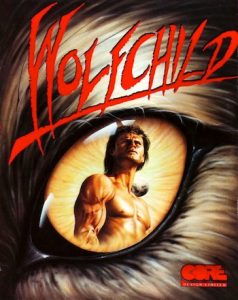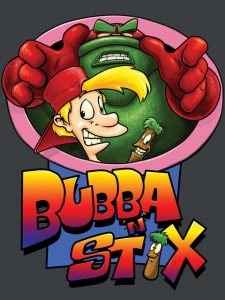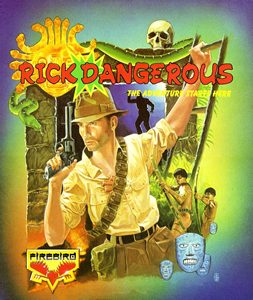 The UK was a hotbed of excellent software design during the ’80s and ’90s. A string of classics came out of the country for all platforms, and computer and console gamers alike enjoyed franchises that are still memorable to this day. Illustrious software houses as Gremlin Graphics, Core Design, and Electronic Arts were pumping out the hits on a regular basis, offering ample opportunity for artists, programmers, and designers to contribute to the exploding video game industry.
The UK was a hotbed of excellent software design during the ’80s and ’90s. A string of classics came out of the country for all platforms, and computer and console gamers alike enjoyed franchises that are still memorable to this day. Illustrious software houses as Gremlin Graphics, Core Design, and Electronic Arts were pumping out the hits on a regular basis, offering ample opportunity for artists, programmers, and designers to contribute to the exploding video game industry.
For almost three decades, Simon Phipps has been creating memorable video game experiences at many of those publishers, including each of the three mentioned above. Phipps has been involved in many major gaming franchises, including the much-loved Rick Dangerous. Genesis fans will recognize his work in several titles, including Wolfchild, Bubba ‘n Stix, and Asterix and the Power of the Gods. Phipps currently works for Three Fields Entertainment, the makers of such hits as Burnout and BLACK.
Sega-16 recently had a chance to speak to Mr. Phipps about his work on the Genesis and Sega CD.
Sega-16: How did you get your start at Core Design?
Simon Phipps: I joined Gremlin’s Derby office as a graphic artist in late 1987, quitting a career as a applications programmer for a typesetting company. (It was a risky move, I took a drop in salary and thought that it wouldn’t last, here I am 29 years later, clearly it must’ve worked out.) I worked at Gremlin for a number of months as an artist and while there taught myself 68000 so I could lend a hand writing tools software and then started to write my own games. Unfortunately, in early 1988 Gremlin hit a cash crisis and was forced to make some cutbacks, one of which required the closing of the Derby office. The small group of us that worked there didn’t find the prospect of travelling the 80-mile round trip to Gremlin’s main office in Sheffield every day appealing so decided to take redundancy. Then Jeremy Smith, Kevin Norburn and Greg Holmes (all of Gremlin) decided to start a company, offering us the opportunity of working for them in the same office so we took the chance on them and Core Design was formed.
Sega-16: Core did some incredible things with the Sega CD, like Soulstar, despite the machine’s data access limitations. What was your initial impression of the hardware? Were you surprised that Core could achieve so much with it?
Simon Phipps: All credit to that must go to the incredibly talented Mark Avory who dove into the hardware and made the Sega CD work miracles. The scaling/pseudo 3D effects that he got out of the machine were exploited to the fullest by as many of the teams at Core as possible.
As goes the hardware, it was like any other add-on that gets thrown into the middle of a hardware cycle by a manufacturer – it’s always an ugly compromise because the original console was never really designed for expansion in mind. It’s sadly something that you make what you can of while it lasts. You hope that the manufacturer sells enough units that there are customers for your games but you’re always making them with a bit of wary eye that you’re only making those games for a small portion of the whole console market. So like all the disc drives, cameras and novelty controllers that have come along mid-cycle since, you get in, do your best, and get out as fast as you can because your core audience (no pun intended) is still the massive amount of folks that haven’t got that hardware. But to Core’s credit, and thanks to Mark’s genius, we hit the hardware right at the correct time, did a variety of different types of game very quickly and made the most of the Sega CD.
My fondest memory of that time was doing some playtesting on Mark’s Soulstar game – playing it non-stop to death for hours and hours and hours… so much so that in the early hours of the morning as I was driving home I could still see stars, bullets and spaceships swarming towards me.
Sega-16: You’ve mentioned Wolfchild was originally conceived as a game that was different from what was released. How different was the original design? Did Capcom’s Strider make a big enough impact to convince you to alter the design?
 Simon Phipps: Not drastically – I’d made the flick-screen platform game Switchblade on the Amiga and Atari back in 1989. At the time, my graphics skills weren’t quite so developed so the characters for the game ended up being cartoon proportions. By the time I started on the initial idea for Wolfchild, my confidence in drawing and animating more realistically proportioned characters had come on, so I originally conceived of Wolfchild as being a more large-scale, scrolling version of what Switchblade had been… but with werewolves.
Simon Phipps: Not drastically – I’d made the flick-screen platform game Switchblade on the Amiga and Atari back in 1989. At the time, my graphics skills weren’t quite so developed so the characters for the game ended up being cartoon proportions. By the time I started on the initial idea for Wolfchild, my confidence in drawing and animating more realistically proportioned characters had come on, so I originally conceived of Wolfchild as being a more large-scale, scrolling version of what Switchblade had been… but with werewolves.
This was an ambitious task – I was used to coding and creating art for my games and clearly it wasn’t possible for me to do the whole job by myself any more. So, I partnered up with my old school friend, John Kirkland who took on the bulk of the coding duties while I concentrated on making the art, designing the game and writing the tools. At that point, Strider had turned up on the scene with its key feature – a character that ran along more than just flat surfaces, so we decided to follow that lead. I’m sure there may have been other influences too, but it’s been a while…
Sega-16: Taking advantage of the extra storage provided by CDs, you went back and added an animated intro sequence for the Sega CD version of Wolfchild. Development time was limited though, so was there perhaps anything you wanted to include but couldn’t?
Simon Phipps: There’s always lots more things you want to put in a game but can’t. As I recall, the big thing about what we did for the Sega CD was to make more levels, add much more colour to all the graphics (the original Atari/Amiga versions had more limited palettes), and I got the opportunity to go to town on the intro sequence – that was plenty enough to take on for that version. With Mega Drive, and Sega CD done, I then had to add even more colour to the graphics for the SNES version, and then spend several months cutting everything down to the smallest and most limited number of characters and colours for the Sega Master System and Game Gear versions…
By the end of May 1993, after 18 months of working on the game and all the various conversions, I’d had enough of werewolves…
Sega-16: Bubba ‘n Stix is quite an unorthodox platformer, and its origins seem to be so as well. What do you think convinced management to green light its development? Do you feel those strengths actually came through in the
final product?
Simon Phipps: As I’ve told the story many times – I’d spent a lot of time making platform games at Core and late 1992 Jeremy, my boss at Core asked me about making an Indiana Jones-type game using rotoscoped sprites, where the main hero’s weapon would be a stick or staff or a pole of some sort.
I’d already made an Indiana Jones spoof game in Rick Dangerous back when Core began, made a sequel to it, and made Wolfchild and all its conversions. While everyone else was starting to explore 3D, the prospect of making another platformer with janky graphics (those rotoscoped games never looked very nice in my opinion) just didn’t appeal and I couldn’t really think how we could create a platform game for a character with a stick. But, like always, you want to give every idea at least a chance. You see the problem that I’d always had with the original “stick” idea was that a stick is a finite length – is it a pole for pole vaulting? In which case it needs to be easily twice the character’s height… or is it a staff for fighting? Or just merely a stick?
Anyway, one Tuesday evening after work, my buddy, Billy Allison and I sat down with a huge piece of paper and started to brainstorm all the ideas of what things you could do with a stick. We drew lots of little cartoons and after drawing up the obvious, like throwing it, hitting things with it and such the ideas got wilder and sillier, the sticks changed length and laws of physics were broken. We had a fun time with the exercise, but for us, this collection of insane cartoons was never going to work for a rotoscoped Indiana Jones game. So, we presented Jeremy with our sketches, convinced that we’d be spending the afternoon thinking up a new game idea. But Jeremy loved it and said we should make the game full of all the silly ideas with Billy going all out on the animation.
And that’s how I ended up making yet another platform game.
Sega-16: It sounds like making Bubba ‘n Stix was a lot of fun! Do you have any fun anecdotes you could share?
 Simon Phipps: Fun perhaps wasn’t the word. A real hard slog for nine solid months is what I remember of it, with myself, Mark Watson, John Kirkland, and Billy stuck in a dark room with a high ceiling to the early hours of every morning intermittently broken up with runs to the Shell Garage for shortcake biscuits.
Simon Phipps: Fun perhaps wasn’t the word. A real hard slog for nine solid months is what I remember of it, with myself, Mark Watson, John Kirkland, and Billy stuck in a dark room with a high ceiling to the early hours of every morning intermittently broken up with runs to the Shell Garage for shortcake biscuits.
But the mood, well that was quite insane – all four of us got on really well but we kinda went a bit stir crazy, the lunacy of being locked up for so long being powered by the craziness of the concept. So, we did laugh a lot (that hysterical kind), came up with heaps of inexplicable in-jokes and battered our brains to a pulp trying to come up with ways of turning the forty or so sketches we’d done the year before into something resembling a viable game.
I learned an awful lot on that project. Billy taught me so much about animation and how to draw. I’ve never had any formal art training outside of an O level, and Billy was incredibly generous with his time, teaching me ways of looking at objects and characters and various tricks and animation techniques that I use to this day.
Sega-16: How did you feel when given the task of designing Asterix and the Power of the Gods? The name had already been chosen, and there were already other titles in the franchise. Was there a sense of pressure involved? How did you tackle the design process?
Simon Phipps: That was awesome. I grew up loving Asterix, but had never thought I’d ever get a chance to make a game based on the books. Core had already made one Asterix platform game in the form of Asterix and the Great Rescue and were being asked to make another. For some reason or other I was asked to attend a meeting with Sega along with Stefan (Walker) and Rich (Morton) about the game. I think it was maybe the second meeting about what to do and how to elevate the game to something beyond the Great Rescue – as if I recall, that was a great looking but pretty standard side-on platformer.
Anyway, being an Asterix fan the first thing that struck me was that we needed the game to feature the map of Europe that’s always in the books, that the adventure would have to use various countries as levels, and that it needed some kind of quest structure to it – it had to be more than a series of levels that you had to get to the end of. That sold the idea to Sega and so I was tasked with designing the game from there. There was no more pressure involved than usual; I just knew I had to get it right for the fans.
Sega-16: You weren’t familiar with Asterix when you began working on the Power of the Gods, were you? Did you use the previous Mega Drive game or other versions as references in any way?
Simon Phipps: On the contrary, I was a big Asterix fan but it had been about 10 years since I’d picked up a book and read it. By the time I got to work on Asterix, I’d touched on enough licensed properties to realize that the only way to make a licensed game is to immerse yourself in the property you’re adapting – get to know the subject like you’re the biggest fan of it so that whatever you make turns out authentic and contains as many nods to the true fans of the property as possible. This lesson was cemented on Asterix and was the absolute heart of everything I did years later when I got the privilege of making the first Harry Potter games for Electronic Arts.
So, the approach I took for Asterix was to get a stack of all the books I could get my hands on (I think I must’ve had about 30 of them), read them all, and wrote down notes of everything that appeared in the stories that could be used as a quest object. That included a massive list of ingredients that went into Getafix’s magic potion. I then knitted together a storyline and a quest that saw Asterix and Obelix going from country to country in search of all of these items and put together a design document that laid that out. All the way through the design I added footnotes to which book, which page there was a precedent for that item to be used.
The design went to Asterix publishers Les Editions Albert Renée and it was approved. In the end, I got a lovely letter from the publisher thanking me for being so careful with Asterix and making such an authentic game. That really made my day.
As goes the name, yep, someone at Sega had agreed and set the name as Asterix and the Power of the Gods before anyone was consulted on what that meant. Now, “the Gods” in the Asterix books aren’t interventionist ones like say in Greek legends. They’re referred to, but their ‘power’ is never seen. So, what I did was go through all of the Asterix books to try and find some way to justify the name. I found one panel in found on page 19 of Asterix and the Chieftain’s Shield– “To deceive Caesar is to deceive the gods, and the anger of the gods would be terrible,” and that gave me all that I needed. I explained that Asterix was confronting Caesar’s power, which Caesar equated to being “the Power of the Gods,” and with that tenuous link we got away with it.
There is one thing I will say about working on licenses though. It’s a great privilege and a great responsibility to work on a license. If you do it right you have to become the biggest fan of the subject, dive deep, learn all you can and express it through the game. The downside of that is that once you’ve done, you’ve seen too much. I never want to watch another episode of Monty Python, read another Harry Potter book, watch any more James Bond movies… although I think I could manage an Asterix… maybe. That’s why I never want to work on anything to do with Star Wars or Batman… lightsabres and Dark Knights hold a special place in my heart and I don’t want to lose that.
Sega-16: There are attempts to port Rick Dangerous to the Mega Drive and even the 32X! What are your thoughts on these efforts?
Simon Phipps: Hmmm… how can I explain?
For me, Rick Dangerous was 16 weeks of work back in the late ’80s trying to make a platform game that would easily scale across as many computers as possible in the shortest amount of time. I came up with a method of recreating loads of varied Indiana Jones-style traps in a very small amount of memory and we married that to the kind of brutal one-hit-and-you’re-dead gameplay that came from the arcades and games like Jet Set WIlly and all its clones. What we hadn’t realized at the time, where Jet Set Willy and the others relied upon consistent, repeating predictable patterns for their gameplay, we created a game that was full of surprises, inconsistencies and one-off events. We inadvertently created what was more like a memory test than a platform game… although a memory test that shot you with poison darts, dropped rocks on your head and stuck spikes up your… y’know…
 That’s what Rick has been for me – a small thing that we did all that time ago, had fun things about it, had flaws and was a stepping stone on to what I do now. But the fact that anyone remembers the game, let alone writes to ask me about it, more than a quarter-of-a-century later – that’s mind-boggling.
That’s what Rick has been for me – a small thing that we did all that time ago, had fun things about it, had flaws and was a stepping stone on to what I do now. But the fact that anyone remembers the game, let alone writes to ask me about it, more than a quarter-of-a-century later – that’s mind-boggling.
What I’ve come to understand over time is that for the folks that really remember Rick, our silly little game represents a really special time in their lives – hours likely spent with friends laughing, likely wanting to throw things at the TV. It’s become a symbol of one of those perfect times. Now, that’s quite profound and I’m deeply honoured to think that something that I made entertained folks, made them laugh, had enough of an impression on them that it has stayed with them all through the years. Not everyone gets that opportunity to touch people’s lives in such a way and over such a long period of time, so that’s really special to me and I feel really lucky to have this and receive so many nice mails and messages from folks to this day.
But I must confess, I do find the whole retro gaming thing a bit difficult to relate to. You see, for me, I think computers are amazing and the things that they enable to us to create are amazing, and although I’m not a rabid early adopter I really appreciate the new amazing tech we have in the present… I always have. When I got my first BBC Micro, that blew my mind – being able to paint with such vivid colours and finally be able to make cartoons that really animated, playing Doom on the PC and X-wing vs. TIE Fighter – for their time, amazing titles. And always being able to sit and think how lucky I was to be around at a time when such tech existed and to look back over the years and see how far we’ve come in such a relatively short time.
So right now, I’m loving VR – November eighth, we at Three Fields Entertainment had our first VR game coming out on HTC Vive, called Lethal VR. It’s a fast action, arcade-style shooting game where you get to wield a couple of realistic guns in a huge 360-degree high tech firing range. You’re absolutely there; the illusion is utterly convincing. Right now, I’m fortunate enough to have access to an Oculus Rift through work so I’m playing Elite Dangerous. I’ve finally gotten the spaceship I dreamed about when I was 8-years old when the only tech I had was cardboard boxes to climb into. For me, I feel so lucky to be alive at this time to be one of the first people in history…. ever… to experience these new kinds of technology I find it really difficult to understand why anyone would want to spend their time thinking about games that had their time decades ago.
That’s not to denigrate anyone else’s passion. The legions of dedicated retro game fans out there are preserving our history through websites, books and remakes and remembering the names of the folks whose games were the stepping stones to what we play today. And that’s a great thing – all power to them and we folks whose work they’re honouring in this way, we’re grateful for. But my job and my passion is what’s here right now, it’s to make the next new things, to remember all the heritage of what has come before, learn new tools, techniques, skills, push myself and my skills forwards and occasionally try to figure out where we go next. I don’t want to go back; I want to keep moving forwards, and if all this time making games has taught me anything whatever happens, and whatever tech’s coming from just over the horizon, I know it’s going to be awesome.
Sega-16: What’s your fondest memory of working on the Mega Drive?
Simon Phipps: My friends – being stuck in dimly lit rooms with John Kirkland and Billy Allison, high ceilings, crappy wallpaper and more spare Sonic The Hedgehog cartridges than you could mention. You bought a Mega Drive, you got a Sonic. That was the law back then.
Our thanks to Mr. Phipps for taking some time to chat with us!

Recent Comments